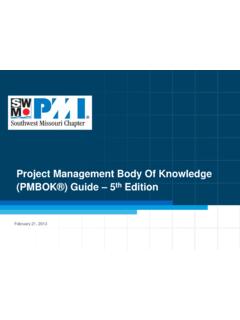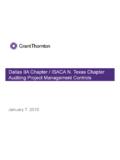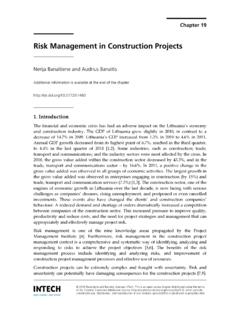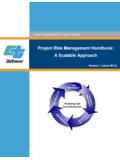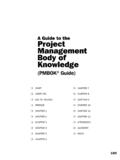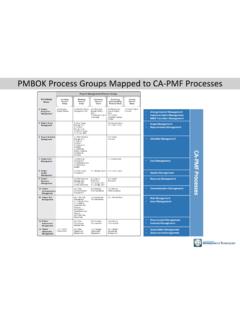Transcription of The Challenge of Managing Risk
1 ChAPter 1 The Challenge of Managing RiskFew would disagree that life is risky. Indeed, for many people it is precisely the element of risk that makes life interesting. However, unmanaged risk is dangerous because it can lead to unforeseen outcomes. This fact has led to the recognition that risk management is essential, whether in business, projects, or everyday life. But somehow risks just keep hap-pening. Risk management apparently does not work, at least not in the way it should. This book addresses this problem by providing a simple method for effective risk management .
2 The target is management of risks on projects, although many of the techniques outlined here are equally applicable to Managing other forms of risk, including business risk, strategic risk, and even personal risk. The book is divided into three parts, starting with defining the problem in an effort to under-stand the underlying reasons for the apparent failure of project risk management to deliver the promised or expected benefits. The main body of the book describes a generic risk manage-ment process applicable to most projects, focusing on simple guidelines to make risk manage-ment work in practice.
3 Finally, the book considers implementation issues, applying the risk management process to different types of projects, and addressing the steps necessary to use risk management effectively. But before considering the details of the risk management process, there are some essential ideas that must be understood and clarified. For example, what exactly is meant by the word risk? Risk The Definition Debate Some may be surprised that there is any question to be answered here. After all, the word risk can be found in any English dictionary, and surely everyone knows what it means.
4 But in recent years risk practitioners and professionals have been engaged in an active and controver-sial debate about the precise scope of the word. Everyone agrees that risk arises from uncertainty, and that risk is about the impact that uncer-tain events or circumstances could have on the achievement of goals. This agreement has led to definitions combining two elements of uncertainty and objectives, such as, A risk is any Lena04_The ATOM 37/7/2012 10:59:40 AM4 Practical project Risk management : The ATOM Methodologyuncertainty that, if it occurs, would have an effect on achievement of one or more objectives.
5 Traditionally risk has been perceived as bad; the emphasis has been on the potential effects of risk as harmful, adverse, negative, and unwelcome. In fact, the word risk has been considered synonymous with threat. But this is not the only perspective. Obviously some uncertainties could be helpful if they occurred. These uncertainties have the same characteristics as threat risks ( , they arise from the effect of uncertainty on achieve-ment of objectives), but the potential effects, if they were to occur, would be beneficial, posi-tive, and welcome.
6 When used in this way, risk becomes synonymous with opportunity. Risk practitioners are divided into three camps around this debate, as illustrated by Figure 1-1: risk the definition debateOne group insists that the traditional approach must be upheld, reserving the word risk for bad things that might happen. This group recognizes that opportunities also exist, but sees them as separate from risks , to be treated differently using a distinct process (row a). A second group believes that there are benefits from treating threats and opportunities together, broadening the definition of risk and the scope of the risk management process to handle both (row b).
7 A third group seems unconcerned about definitions, words, and jargon, preferring to focus on doing the job. This group emphasizes the need to deal with all types of uncertainty without worrying about which labels to use (row c). While this debate remains unresolved, clear trends are emerging. The majority of official risk management standards and guidelines use a broadened definition of risk, including both upside opportunities and downside threats. Some leading procedural standards, such as A Guide to the project management body of knowledge ( pmbok Guide) from the Proj-ect management Institute, and the Association for project management s project Risk Analysis and management (PRAM) Guide, also reflect this wider definition in their risk management Lena04_The ATOM 47/7/2012 10:59:41 AMChapter 1: The Challenge of Managing Risk 5processes, with tools and techniques to identify, assess, and manage both opportunities and threats.
8 Following this trend, increasing numbers of organizations are widening the scope of their risk management approach to address uncertainties with positive upside impacts as well as those with negative downside effects. Given the increasing popularity of the wider application of risk management to both threats and opportunities, as well as the attraction of using a single process to deal with two related concerns, this book adopts the inclusive position. Using a common process to manage both threats and opportunities has many benefits, including.
9 Maximum efficiency, with no need to develop, introduce, and maintain a separate opportunity management process Cost-effectiveness (double bangs per buck ) from using a single process to achieve proactive management of both threats and opportunities, resulting in avoidance or minimization of problems, and exploitation and maximization of benefits Familiar techniques, requiring only minor changes to current techniques for Managing threats so organizations can deal with opportunities Minimal additional training, because the common process uses familiar processes, tools, and techniques Proactive opportunity management .
10 So that opportunities that might have been missed can be addressed More realistic contingency management , by including potential upside impacts as well as the downside, taking account of both overs and unders Increased team motivation, by encouraging people to think creatively about ways to work better, simpler, faster, more effectively, etc. Improved chances of project success, because opportunities are identified and captured, producing benefits for the project that might otherwise have been overlooked.
